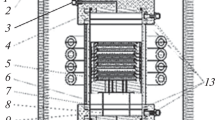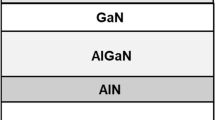Abstract
Silicon carbide thin films were synthesised by vapour phase epitaxy technique on silicon substrates using silane and propane as precursors. Methyltrichlorosilane (MTS) was added, and nitrogen was used as dopant precursor. Samples with different doping concentrations were obtained varying the nitrogen flow during the growth. Doping level for each sample was assessed using Raman technique, and a correlation between dopant flow and doping level was confirmed. The influence of MTS on nitrogen incorporation is analysed and discussed: the introduction of MTS increases the growth rate and increases the doping level. We exclude a direct doping effect by the MTS, but we think that it promotes the incorporation of nitrogen doping species. The crystalline quality of the as-grown films was evaluated using X-ray diffraction, assessing the good crystalline quality even in samples obtained using high growth rates and high doping level.





Similar content being viewed by others
References
Choyke WJ, Matsunami H, Pensl G (2004) Silicon carbide: recent major advances. Springer, Berlin, pp 89–118
Parsons JD, Bunshah RF, Stafsudd OM (1985) Unlocking the potential of beta silicon carbide. Solid State Technol 28:133
Saddow SE, Agarwal A (2004) Advances in silicon carbide processing and applications. Artech House, Norwood, pp 69–108
Roccaforte F, Fiorenza P, Greco G, Lo Nigro R, Giannazzo F, Patti A, Saggio M (2014) Challenges for energy efficient wide band gap semiconductor power devices. Phys Status Solidi 211:2063–2071. doi:10.1002/pssa.201300558
Kimoto T (2015) Material science and device physics in SiC technology for high-voltage power devices. Jpn J Appl Phys 54:40103. doi:10.7567/JJAP.54.040103
Fraga MA, Bosi M, Negri M (2015) Silicon carbide in microsystem technology—thin film versus bulk material. In: Saddow SE, La Via F (eds) Advanced silicon carbide devices and processing. InTech, Rijeka, pp 3–31. doi:10.5772/59734
Nagasawa H, Abe M, Yagi K, Kawahara T, Hatta N (2008) Fabrication of high performance 3C-SiC vertical MOSFETs by reducing planar defects. Phys Status Solidi 245:1272–1280. doi:10.1002/pssb.200844053
Das P, Ferry DK (1976) Hot electron microwave conductivity of wide bandgap semiconductors. Solid State Electron 19:851–855. doi:10.1016/0038-1101(76)90042-3
Shaffer PTB (1966) SiC whiskers. Ceram Age 82:46
Zhou D, Seraphin S (1994) Production of silicon carbide whiskers from carbon nanoclusters. Chem Phys Lett 222:233–238. doi:10.1016/0009-2614(94)00342-4
Negri M, Dhanabalan SC, Attolini G, Lagonegro P, Campanini M, Bosi M, Fabbri F, Salviati G (2015) Tuning the radial structure of core–shell silicon carbide nanowires. CrystEngComm 17:1258–1263. doi:10.1039/C4CE01381F
La Via F, Galvagno G, Foti G, Mauceri M, Leone S, Pistone G, Abbondanza G, Veneroni A, Masi M, Valente GL, Crippa D (2006) 4H SiC epitaxial growth with chlorine addition. Chem Vap Depos 12:509–515. doi:10.1002/cvde.200506465
Bosi M, Attolini G, Negri M, Claudio F, Buffagni E, Frigeri C, Calicchio M, Pécz B, Riesz F, Cora I, Osváth Z, Jiang L, Borionetti G (2016) Defect structure and strain reduction of 3C-SiC/Si layers obtained with the use of buffer layer and methyltrichlorosilane addition. CrystEngComm 18:2770–2779. doi:10.1039/C6CE00280C
Larkin DJ (1997) SiC dopant incorporation control using site-competition CVD. Phys Status Solidi 202:305–320. doi:10.1002/1521-3951(199707)202:1<305:AID-PSSB305>3.0.CO;2-9
Matsunami H, Kimoto T (1997) Step-controlled epitaxial growth of SiC: high quality homoepitaxy. Mater Sci Eng R Reports 20:125–166. doi:10.1016/S0927-796X(97)00005-3
Camassel J, Juillaguet S, Zielinski M, Balloud C (2006) Application of LTPL investigation methods to CVD-grown SiC. Chem Vap Depos 12:549–556. doi:10.1002/cvde.200606472
Yugami H, Nakashima S, Mitsuishi A, Uemoto A, Shigeta M, Furukawa K, Suzuki A, Nakajima S (1987) Characterization of the free-carrier concentrations in doped β-SiC crystals by Raman scattering. J Appl Phys 61:354. doi:10.1063/1.338830
Piluso N, Severino A, Camarda M, Anzalone R, Canino A, Condorelli G, Abbondanza G, La Via F (2010) Raman Characterization of doped 3C-SiC/Si for different silicon substrates and C/Si ratios. Mater Sci Forum 645–648:255–258. doi:10.4028/www.scientific.net/MSF.645-648.255
Piluso N, Severino A, Camarda M, Canino A, La Magna A, La Via F (2011) Raman study of bulk mobility in 3C-SiC heteroepitaxy. Mater Sci Forum 679–680:221–224. doi:10.4028/www.scientific.net/MSF.679-680.221
Klein MV (1983) Light scattering in solids I. Springer, Berlin, pp 23–78. doi:10.1007/3-540-11913-2
Bosi M, Attolini G, Negri M, Frigeri C, Buffagni E, Ferrari C, Rimoldi T, Cristofolini L, Aversa L, Tatti R, Verucchi R (2013) Optimization of a buffer layer for cubic silicon carbide growth on silicon substrates. J Cryst Growth 383:84–94. doi:10.1016/j.jcrysgro.2013.08.005
Zielinski M, Portail M, Chassagne T, Juillaguet S, Peyre H (2008) Nitrogen doping of 3C-SiC thin films grown by CVD in a resistively heated horizontal hot-wall reactor. J Cryst Growth 310:3174–3182. doi:10.1016/j.jcrysgro.2008.03.022
Pedersen H, Beyer FC, Hassan J, Henry A, Janzén E (2009) Donor incorporation in SiC epilayers grown at high growth rate with chloride-based CVD. J Cryst Growth 311:1321–1327. doi:10.1016/j.jcrysgro.2008.12.029
Fiorucci A, Moscatelli D, Masi M (2007) Homoepitaxial silicon carbide deposition processes via chlorine routes. Surf Coat Technol 201:8825–8829. doi:10.1016/j.surfcoat.2007.04.110
Kim G-H, Efremov AM, Kim D-P, Kim C-I (2005) Inductively coupled Cl2/N2 plasma: experimental investigation and modeling. Microelectron Eng 81:96–105. doi:10.1016/j.mee.2005.04.003
Author information
Authors and Affiliations
Corresponding author
Ethics declarations
Conflict of interest
Author Matteo Bosi has received research grants from Anvil Semiconductors Ltd. The authors declare that they have no conflict of interest.
Rights and permissions
About this article
Cite this article
Negri, M., Bosi, M., Orsi, D. et al. Effect of a halogen-based precursor on dopant incorporation in 3C-SiC film epitaxy. J Mater Sci 52, 9787–9793 (2017). https://doi.org/10.1007/s10853-017-1164-9
Received:
Accepted:
Published:
Issue Date:
DOI: https://doi.org/10.1007/s10853-017-1164-9




